Staying Chases
I am looking at staying handicap chases and whether there are any patterns and trends that will give us, the punter, some sort of edge over the ‘crowd’. For a staying chase I have decided on a race distance of at least 3 miles. I have looked at just under 6 years of data from UK racing, and profit/losses have been calculated to £1 level stakes at Betfair Starting Price (BSP).
Price – Let us looks at the market factors first. I am breaking the prices down by Industry SP, but as stated earlier, profit and loss will be calculated to BSP.
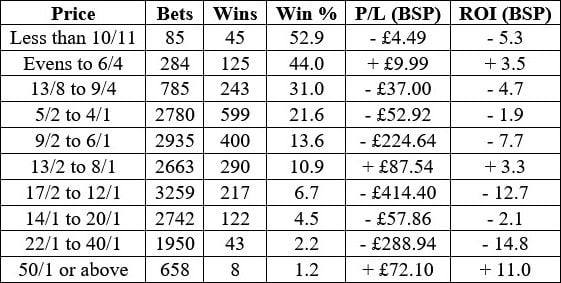
Strike rates correlate as you would expect but there are no real patterns with the profit/loss figures. Possibly the best area to concentrate on is the 4/1 or shorter bracket.
Age – time to look at age of horses now to see whether that gives us any useful pointers:
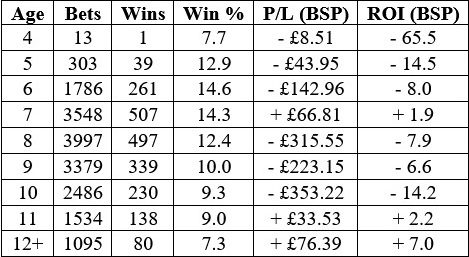
Very few horses 5 or younger contest these events and it seems the most successful band, in terms of strike rate at least, is the 6 to 8yo age bracket.
Horses aged 11 or older have made a profit overall but this is basically down to the odd big, priced winner.
Position LTO – how the horse preformed last time in terms of finishing position is next on my agenda. Many punters use this factor as one of their considerations. Here are the stats:
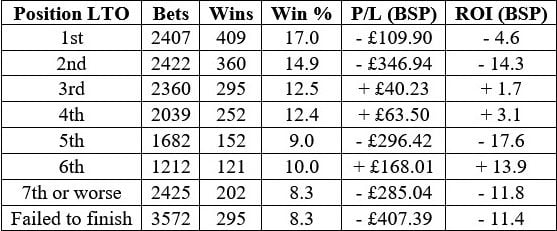
Horses finishing 3rd or 4th last time out have both proved profitable, albeit to very low levels.
Probably the key part to take from here is that you are better off avoiding horses that finished 7th or worse LTO and also those who failed to complete the course (e.g., fallers, horses that were pulled up, etc).
Days since last run – this is a barometer again that many punters look at.
Let us see if an edge can be gleaned here for staying chasers:

Here is an area that we may be able to use to our advantage. Returning to the track within 15 days has proved profitable with a decent enough strike rate. I find this very interesting as 3 mile plus handicap chases are a bit of a slog and I had expected to see that quick returners struggled a bit.
In fact, the stats seem to suggest that in general the shorter the break the better; it makes sense to also avoid horses that have been off the track for around 7 weeks or more.
Weight rank – the weight carried by a horse is always worth investigating in handicaps. Here I have split the weight into sections. Here are the findings:

Higher weighted runners win more often but it is lower weighted animals that have actually proved profitable. Definitely something to keep in mind.
Trainers – a look now at the trainers who have achieved the most success in these handicap chases. Only trainers with 100+ runs have made the list. The cut-off point is 14% in terms of strike rate:
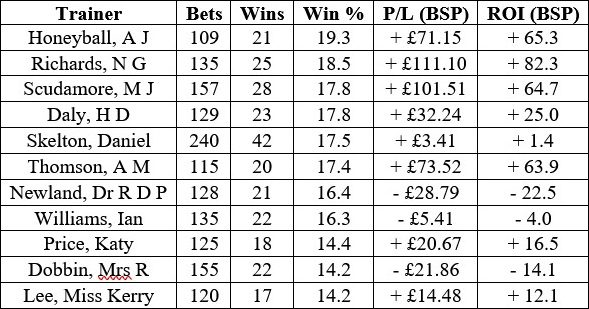
Some positive stats here with these top performing trainers.
However, another indicator of trainer success is to work out what percentage of their individual horses actually won at least one race.
Sometimes trainer stats are skewed by one or two extremely successful horses, so this perhaps gives us a more complete picture.
Below the table shows what percentage of their runners actually won at least one race:

You have to say those trainers whose percentage is above 40 have done extremely well. Richards and Scudamore are even above 50% which is remarkably impressive.
They certainly know how to train a staying chaser and get them race ready.
For all the positive trainer stats, it is worth noting those trainers who are not as successful. Below are the trainers who have struggled a bit over the past few seasons in these contests:

Sires – the top 10 sires with 100 + runs are shown below. National Hunt sire data is still unused by the vast majority of punters.
I do, however, feel it is an area to be aware of and take note of:
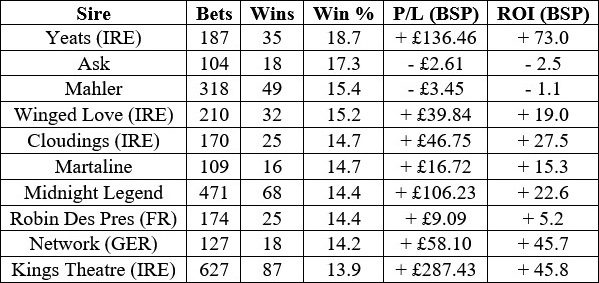
I would keep an eye on these sires in 3 mile plus handicap chases, and it would be an added bonus if one of them were the sire of a horse you were keen to back.
As with all types of races there is no one method or system that works consistently. You need a good overview of several factors, coupling that with your own ability to read a race and weigh up the runners in question. As you have seen in this article, some factors are more important than others.
Hopefully sharing this information with you puts you in a better position to tackle these races in the future.
David Renham


